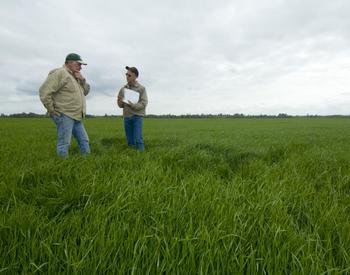[GUITAR PLAYING]
My name is Sergio Arispe and I'm with the Oregon State
University Extension Service.
Nitrate toxicity in cattle is a noninfectious condition
whereby animals consume feed, forage,
and water sources at detrimental and potentially lethal
concentrations.
This leads to internal suffocation, or anoxia.
Nitrate toxicity is preventable.
Therefore, it is important to identify potentially lethal
nitrate sources, the symptoms associated with the condition,
and how to implement strategies to prevent losses
to an operation.
Animals suffering from nitrate toxicity
may exhibit off-color mucus membranes,
respiratory distress, weakness, and/or staggering.
Several factors cause nitrates to accumulate in plants.
These include the following.
Nitrates tend to accumulate in hot, dry weather.
However, it does not always coincide
with drought conditions.
Soil moisture is needed for plants
to absorb nitrate from the soil, so nitrates
tend to accumulate in plants several days
after the first rain that restores soil moisture.
Crops, weeds, and forages can accumulate nitrates,
with some plants accumulating more nitrates than others.
Some crops commonly associated with nitrate toxicity
include orchardgrass, alfalfa, barley, sorghum, and fescue.
Some of the common weeds that accumulate nitrates
include kochia, lamb's quarters, fiddleneck, Russian thistle.
Immature plants generally have higher nitrate concentrations
compared to mature plants.
Nitrates mainly accumulate in the stalk
or in the bottom third of the plant.
Nitrates accumulate after successive cloudy days
or in valleys without sunlight.
Herbicides like 2,4-D can cause nitrates to accumulate
in plants.
Plant diseases that disrupt photosynthesis
can lead to lethal nitrate levels in cattle.
Prevention is the most effective way
to manage nitrate toxicity in your cow herd.
Understanding that several factors influence
nitrate accumulation in forages, feed, and water sources
can keep your beef-cattle herd profitable.
For more information, you can visit your local extension
office.
















